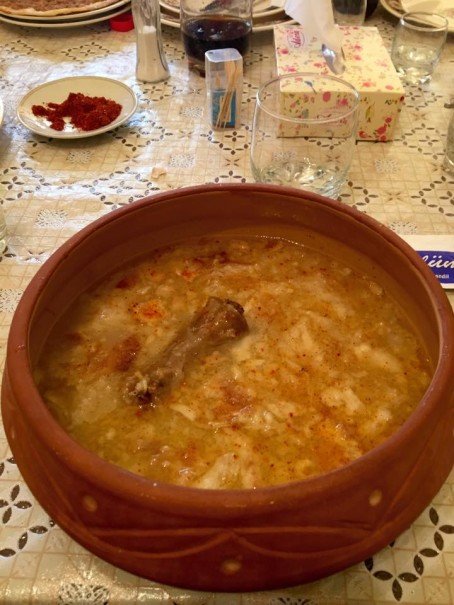
Bones, Garlic, and Vodka in Armenia

Bones, Garlic, and Vodka in Armenia
The combination of vodka, garlic, and molten ligaments on an early-morning stomach may seem a questionable concept to some, but in Armenia, they form the breakfast trinity of a time-tested tradition. Khash is not merely a form of sustenance, it is a ritual. It is a divine right bestowed upon those who can appreciate its cacophony of smells, sights, and flavors.
In the past, the rich would eat the meat of an animal, leaving the bones and joints for their less affluent counterparts. Today, khash, a hearty stew made from boiled bones and joints, is a unifying force in any Armenian community, regardless of social class. Originating from the Armenian word “khashel,” meaning “to boil,” khash has become a staple of Armenian culture. To prepare the stew, cow shanks are simmered for over 24 hours, allowing the gelatin to melt into the gelatinous, milky broth that the bones and the rest of the ligaments are served in. The laborious process requires hours of cleaning and preparation before the bones are even placed into the pot.
In villages, the stew is usually eaten on a daily basis during the winter, as it provides insulation against the cold. The khash is served piping hot, straight from hours of simmering. A traditional khash service requires the server to place the bowls into boiling water before the soup is poured in, eradicating the risk that the cold bowl would cool the soup even a few degrees. Paired with a shot of vodka, it will instantly heat your body, even after a four-mile hike through the snow.
The relatively plain broth is garnished with garlic, lemon, and salt. Lavash bread, a flatbread that is a staple on Armenian tables, is dried and served with the stew. Most people crush the lavash into the stew to give it more bulk. Fresh and pickled turnips, seasonal greens, cheese, naturally carbonated water and, of course, the ever-present vodka are the perfect sides.
For a people with a high regard for dining and entertainment, khash has become a ceremony around which Armenian hospitality revolves. If one is invited to a meal of khash and does not accept, it is a social faux pas. Although khash has many benefits, it can also be a double-edged sword. The larger your circle of friends, the more invitations to khash ceremonies. One’s liver is put to the ultimate test as the opportunities for consuming large amounts of vodka before 10 a.m. increase.
Khash is a rite of passage. It is a way of accepting someone into your inner circle and making them feel welcome. People who eat khash together stick together. Relations improve and formalities begin to fade away. Traditionally, people chose to forgo the use of utensils altogether, opting to eat with their hands or, for the more adventurous, to drape a towel over their head and slurp the soup. As the bowls begin to empty, the toasts become warmer and the friendships become stronger. Khash is a good reminder that the ritual can be just as potent as the meal.